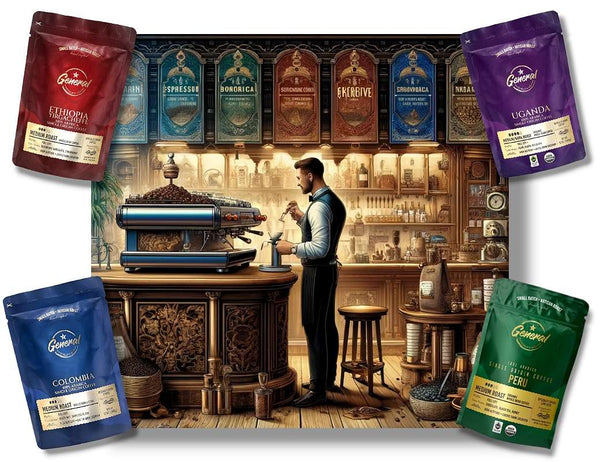Understanding Arabica Coffee Cultivars: A Comprehensive Guide
Arabica Coffee Varieties

From the lush highlands of Ethiopia to the picturesque landscapes of Latin America, Arabica coffee (Coffea arabica) reigns supreme as one of the most revered and sought-after coffee species in the world. With its distinct flavors, tantalizing aromas, and captivating history, Arabica coffee has secured a place in the hearts and cups of coffee enthusiasts worldwide.
In this article, we embark on a flavorful journey of several of the many captivating cultivars of Arabica coffee, exploring their unique characteristics and origins.
What Are Arabica Coffee Hybrids?

Arabica coffee hybrids are the result of natural or selective crossbreeding of two different species or two different cultivars of the same species. These hybrids often combine favorable traits from the parent plants, such as disease resistance, yield, or flavor profiles. The process involves pollination between selected coffee plants to produce offspring with desired characteristics. The aim is to improve the overall quality and sustainability of coffee cultivation while preserving the unique flavors and attributes of the Arabica species.
What Are Arabica Coffee Cultivars?

Arabica coffee cultivars are varieties of Coffea arabica (Arabica plant), a species of coffee plant known for producing high-quality coffee beans. Cultivars are intentionally bred to enhance specific traits like flavor, yield, and disease resistance that are not normally found in nature. These selections offer diverse taste profiles, suited to various growing conditions and preferences. Let's explore several of our favorites below:
1. Ethiopian Heirloom: The Mother of All Arabica Coffee
Our journey begins in the birthplace of coffee itself: Ethiopia. Here, the Ethiopian Heirloom variety stands tall as the progenitor of all Arabica coffee. As ancient as time, this variety boasts a rich, fruity aroma and an astonishing range of flavors. The beans are cultivated on diverse Ethiopian terroirs, from the misty forests of Jimma to the sun-kissed hills of Yirgacheffe. With a fascinating mix of cultivars, each cup unravels a tale of flavor complexity and depth.
2. Yirgacheffe: The Floral Symphony
Nestled in the southern Ethiopian highlands, the Yirgacheffe region produces an exceptional Arabica coffee with a unique floral character. Grown at elevations between 1,700 to 2,200 meters (5,577.43 to 7,217.85 feet) above sea level, Yirgacheffe beans exhibit delicate and vibrant floral notes, often complemented by hints of citrus and berries. This coffee is often processed using the traditional washed method, further enhancing its bright acidity and clean finish.
3. Sidamo: The Fruity Euphoria
Adjacent to Yirgacheffe lies the Sidamo region, where Arabica coffee beans thrive in rich volcanic soil. Sidamo coffee delights the senses with its fruity and wine-like taste profile, a tantalizing blend of sweet berries, tropical fruits, and hints of spice. A sip of Sidamo coffee is an exploration of flavor euphoria, leaving the palate dancing in delight.
4. Harrar: The Mocha Marvel
Venturing to the eastern part of Ethiopia, we discover the Harrar region. Here, Arabica coffee cherries are sun-dried with their fruity pulp, imparting the beans with an unmistakable wild and natural character. Known for its distinct Mocha flavor profile, Harrar coffee exhibits a harmonious mix of chocolate, spice, and ripe fruit notes, making each cup a unique and memorable experience.
5. Bourbon: The Classic Elegance
Leaving Africa and journeying across the seas to Latin America, we encounter the Bourbon variety. Revered for its classic elegance, Bourbon coffee is believed to have originated on the island of Bourbon (now Réunion) in the Indian Ocean. This coffee variety is celebrated for its smooth and well-balanced taste, often presenting a delightful blend of caramel, vanilla, and subtle fruity undertones.
6. Typica: The Heritage Bean
As we traverse the vast coffee plantations of Central America, we encounter the Typica variety, an iconic heritage bean that has shaped the coffee industry for centuries. With its distinct elongated shape and mellow flavor profile, Typica beans have served as a foundation for many other Arabica coffee varieties. From the gentle slopes of Guatemala to the fertile lands of Costa Rica, Typica continues to captivate coffee enthusiasts with its historical charm and pleasing taste.
7. Geisha (Gesha): The Pinnacle of Elegance
In the enchanting landscapes of Panama and Ethiopia, we discover the regal Geisha coffee variety, often regarded as the pinnacle of coffee elegance. Revered for its exceptional clarity and vibrant floral bouquet, Geisha beans present a symphony of jasmine, bergamot, and tropical fruit notes. Its exquisite flavors and limited availability have made Geisha coffee one of the most sought-after and expensive varieties in the world.
8. Colombian Supremo: The Bold Andean Elegance (Hybrid)
Colombia, with its ideal coffee-growing conditions, is renowned for producing some of the finest Arabica coffee in the world. Among its notable varieties, Colombian Supremo stands tall as a symbol of excellence. Grown in the high-altitude regions of the Andes, this coffee exudes a bold and balanced flavor profile, with notes of caramel, chocolate, and a hint of citrus acidity. The Supremo beans' large size allows for a more consistent roasting process, ensuring a remarkable and delightful cup every time.
9. Brazilian Bourbon Santos: The Robust Beauty
In the vast coffee plantations of Brazil, we find the Brazilian Bourbon Santos, a variety that embodies the country's coffee legacy. With a focus on the sweet and full-bodied experience, Bourbon Santos exhibits nutty undertones, caramel sweetness, and a pleasant hint of bitterness. As one of Brazil's most cherished Arabica coffee varieties, it plays a crucial role in their prominent position as the world's largest coffee producer.
10. Costa Rican Villa Sarchi: The Tropical Gem
Nestled between the Caribbean Sea and the Pacific Ocean, Costa Rica boasts an abundance of diversity. One standout variety is the Villa Sarchi, a natural mutation of the Bourbon variety. Grown on volcanic soils, Villa Sarchi entices coffee enthusiasts with its juicy and vibrant flavor profile. With a medley of bright acidity, fruity notes, and a subtle floral aroma, this variety is a true tropical gem.
11. Ecuadorian Galapagos Typica: The Rare Discovery
While not as well-known as some other coffee-growing regions, the Galapagos Islands in Ecuador harbor a unique Arabica coffee variety: Galapagos Typica. This rare discovery delivers a distinctive and exotic experience. The isolation of the islands and volcanic soil contribute to the beans' exquisite flavors, which often include tropical fruit notes and a pleasant acidity that captures the essence of this remarkable ecosystem.
12. Peruvian Tunki: The High-Altitude Jewel
Peru, home to the majestic Andes mountains, boasts the Tunki variety, cultivated at elevations reaching up to 2,000 meters above sea level. The high altitude and unique microclimates create an exceptional coffee with a diverse range of flavors. Tunki coffee is characterized by its vibrant acidity, floral aromas, and a medley of fruit notes, including berries and stone fruits. This high-altitude jewel represents the dedication and passion of Peruvian coffee farmers.
13. Venezuelan Maracaibo: The Exotic Indulgence (Hybrid)
Venturing to the northern coast of South America, we find Venezuela's Maracaibo region, known for its distinguished Arabica coffee. Maracaibo coffee presents an exotic indulgence with flavors that are rich and intense, often featuring dark chocolate, spices, and tropical fruit notes. The cacao-like undertones pay homage to the region's renowned chocolate heritage, creating an exquisite and memorable cup.
14. SL28 and SL34: The Kenyan Powerhouses (Hybrids)
In the high-altitude plateaus of Kenya, we encounter the SL28 and SL34 varieties, renowned for their full-bodied and intensely flavored cups. These Kenyan powerhouses dazzle the palate with their bold acidity, jammy sweetness, and savory complexity. Their unique taste profiles often include notes of blackcurrant, red grape, and savory tomato, creating a memorable and robust coffee experience.
Conclusion

As our journey through the captivating varieties of Arabica coffee comes to an end, we reflect on the diversity and splendor of this beloved species. From the ancient Ethiopian Heirloom to the rare Geisha, each Arabica variety we explored showcased the remarkable influence of terroir, climate, and traditional cultivation methods on the final cup.
As you enjoy your next cup of Arabica coffee, take a moment to savor the rich history and intricate flavors encapsulated within each bean. Whether it's the floral allure of Yirgacheffe or the boldness of Kenyan SL28, Arabica coffee continues to enchant and inspire, uniting coffee lovers around the world in their passion for this beloved beverage. Ready to embark on a journey to unmask the flavors of the finest specialty coffees from around the world?






Leave a comment